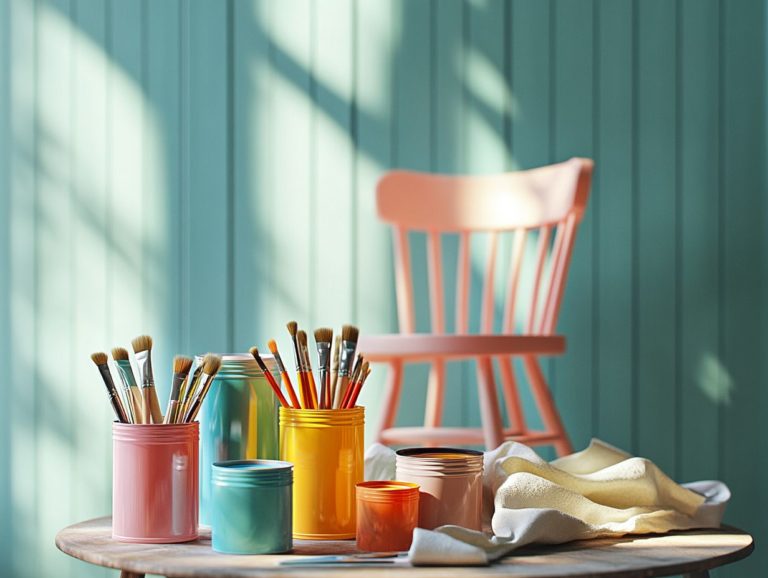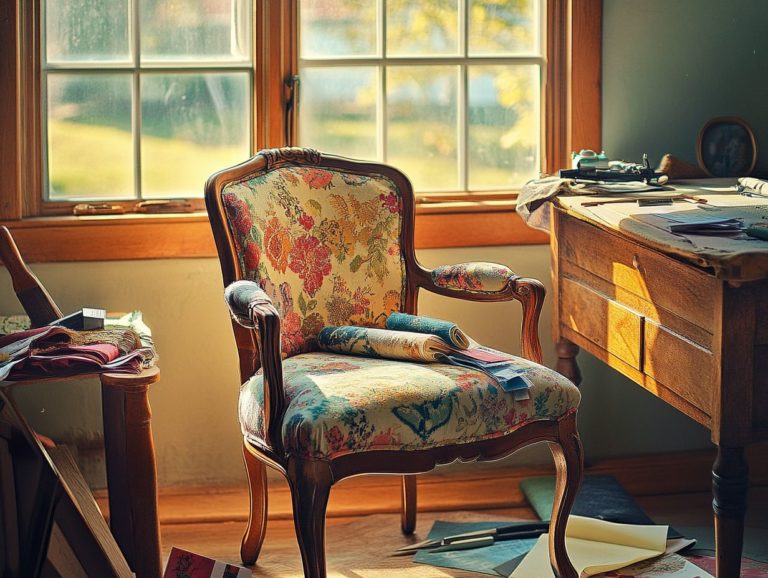DIY Restoration: Breathing Life into Old Cabinets
Is your kitchen or bathroom feeling a bit dated because of worn-out cabinets? Cabinet restoration could be the perfect solution to invigorate your space without the steep costs associated with a full remodel.
Discover the amazing benefits of restoring your old cabinets! From saving money to helping the environment, we ll guide you through it all. You ll uncover practical steps for a successful restoration and receive valuable tips for maintaining those stunning cabinets for years to come.
Whether you re a seasoned DIY enthusiast or just beginning your journey, this guide will empower you to transform your old cabinets into captivating focal points. Start now and transform your cabinets!
Contents
- Key Takeaways:
- Benefits of Restoring Old Cabinets
- Assessing the Condition of Your Cabinets
- Preparing for Cabinet Restoration
- Step-by-Step Guide to Restoring Cabinets
- Maintaining Restored Cabinets
- Alternatives to DIY Restoration
- Frequently Asked Questions
- What materials do I need for DIY restoration of old cabinets?
- Can I restore cabinets that are in poor condition?
- How do I prepare the cabinets for restoration?
- Do I need to prime before painting or staining the cabinets?
- Can I change the color of my cabinets during restoration?
- How long does DIY cabinet restoration take?
Key Takeaways:
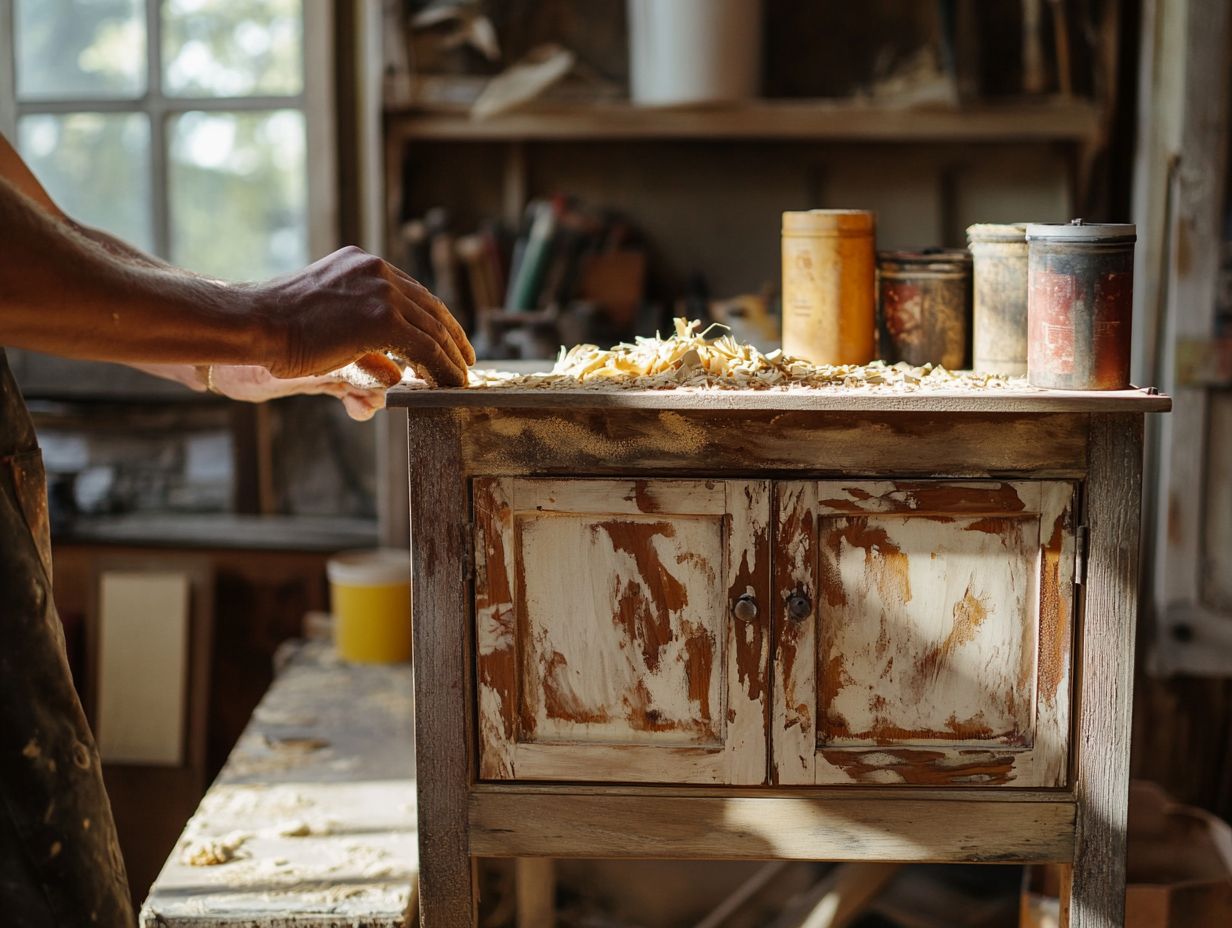
- Save money and help the planet by restoring old cabinets.
- Assess the condition of your cabinets and plan necessary repairs before beginning restoration.
- Proper cleaning, sanding, and refinishing techniques will ensure the longevity of restored cabinets.
What is Cabinet Restoration?
Cabinet restoration is all about breathing new life into your old cabinets, enhancing both their look and functionality. You can elevate your kitchen by exploring various restoration techniques, such as refinishing cabinets (removing old paint or varnish), replacing hardware, and applying protective measures for longevity.
Understanding methods like sanding cabinets and utilizing products such as Howard Restor-A-Finish and Howard Feed-N-Wax will serve you well. Don’t overlook the wealth of DIY inspiration from experts like Nick Slavik and trusted sources like This Old House. For a great project, check out this DIY restoration guide on bringing back old garden furniture.
Your journey begins with a careful assessment of your cabinets condition. This helps you determine the best approach. Refinishing entails stripping away tired old finishes to unveil the beautiful wood beneath, which you can then stain or paint to achieve your desired aesthetic. Selecting the right wood finish is crucial; it impacts the visual appeal and offers essential protection against everyday wear and tear.
Another popular option is cabinet refacing, which means replacing the visible parts of the cabinet while keeping the original structure. By tapping into expert recommendations and quality products, you can achieve stunning results that truly rejuvenate your space. For those interested in more extensive projects, DIY restoration: reviving vintage bedroom sets can offer inspiring ideas.
Benefits of Restoring Old Cabinets
Restoring old cabinets provides you with numerous advantages, such as great savings, an uplift in your home’s aesthetics, and a reduced environmental footprint. This approach stands out as an exceptional choice for those contemplating a kitchen remodel.
By effectively restoring your cabinets, you can preserve the quality of existing materials while achieving a fresh, modern appearance without the hefty price tag of a complete installation. For those looking to tackle scratches, consider DIY restoration techniques to enjoy the benefits of easy refinishing.
Cost Savings and Environmental Impact
One of the main advantages of cabinet restoration is the great savings it offers compared to purchasing new kitchen cabinets, all while benefiting the environment. You can avoid the hefty price tag associated with new cabinetry and contribute to reducing waste by extending the life of existing materials.
This approach maintains the unique character of your home and significantly reduces landfill contributions, making it an eco-friendly choice. The financial benefits become even clearer when you realize that refinishing can cost just a fraction of new cabinets, averaging around $1,200 to $3,000 based on the project’s scope. In contrast, new cabinetry can easily soar past $10,000. For those looking to refresh old wooden toys, consider a DIY restoration project that not only preserves their charm but also aligns with sustainable practices.
By repurposing and reusing materials, you engage in sustainable practices that positively impact the environment, lowering the demand for new resources and the carbon footprint linked to manufacturing. Cabinet restoration is a wise and responsible choice for budget-conscious homeowners looking to stylishly update their space while supporting greener living.
Assessing the Condition of Your Cabinets
Get ready to breathe new life into your cabinets! Assessing their condition is the first step to an amazing kitchen makeover. Before diving into a cabinet restoration project, take a moment to evaluate the condition of your cabinets. This assessment is crucial for identifying any necessary repairs and determining the optimal approach to restore them to their former glory.
By meticulously examining your cabinets, you can uncover issues like peeling finishes, warped wood, or damaged doors. These insights will not only guide your refinishing efforts but also pave the way for a truly successful kitchen transformation.
Identifying Necessary Repairs
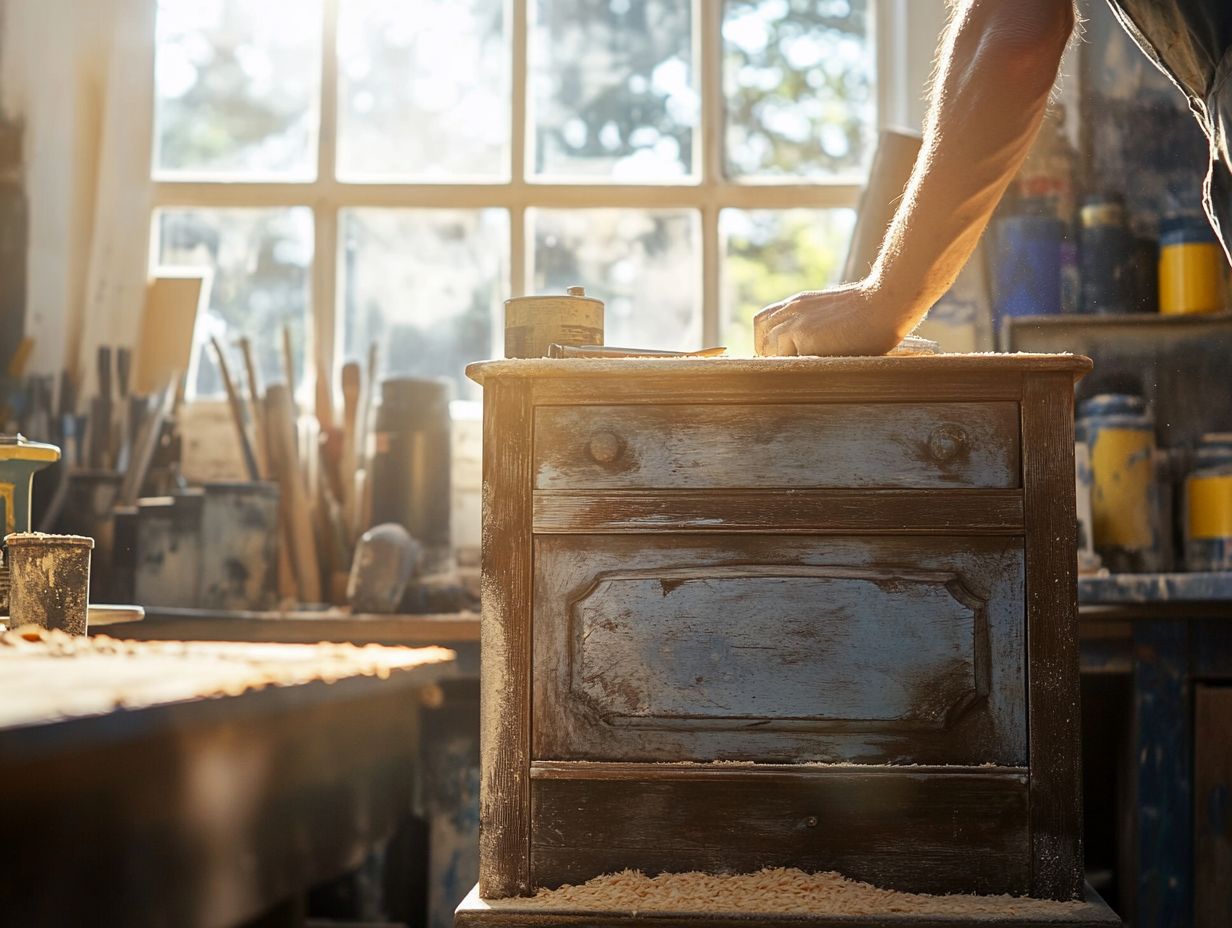
Identifying necessary repairs is an essential step in your cabinet restoration journey. This ensures that your old cabinets are not only structurally sound but also visually appealing. As a homeowner, be on the lookout for issues like damaged cabinet doors, loose hardware, and signs of moisture damage. Tackling these problems early will set the stage for a more successful and lasting restoration.
Common repair issues often include worn-out hinges that can cause doors to sag or fail to close properly. Fortunately, this is easily resolved by replacing them with sturdy, new hinges made from durable materials like stainless steel.
Surface scratches can detract from the overall aesthetic, but don’t worry; these can typically be filled with wood filler or touch-up pens designed to match the original finish. If you encounter moisture damage, it’s crucial to apply proper sealing techniques, such as using high-quality sealants to prevent future issues. For more extensive projects, check out our DIY restoration tips for refinishing wood. By recognizing and addressing these challenges, you can help your cabinets regain their former glory.
Preparing for Cabinet Restoration
Proper preparation is paramount to your cabinet restoration project s success. It entails a thoughtful selection of tools and materials essential for each stage of the process be it cleaning, sanding, or applying finishes.
As a homeowner, gather vital supplies such as rubber gloves, synthetic steel wool, and effective cleaning agents like Trisodium phosphate (a strong cleaner that helps prepare surfaces). Planning carefully leads to a smooth restoration experience.
Tools and Materials Needed
To embark on a successful cabinet restoration project, you ll require a range of tools and materials, including rubber gloves, synthetic steel wool, and effective cleaning agents like KILZ 3 to prepare your cabinets for refinishing. Having the right supplies not only streamlines the process but also elevates the quality of your restoration outcome.
In addition to these essentials, it s wise to invest in a set of quality paintbrushes. Opt for small detail brushes for intricate areas and larger ones for broader surfaces. Sanding tools, whether manual or electric, will be invaluable in smoothing out any rough patches to ensure a flawless finish. Safety equipment, such as masks and goggles, is crucial to protect against dust and fumes.
Selecting the appropriate finishes whether water-based or oil-based will significantly enhance the durability and aesthetics of your cabinets. This makes careful planning all the more essential for achieving an elegant final product.
Step-by-Step Guide to Restoring Cabinets
A step-by-step guide to restoring cabinets enables you to navigate the entire process with confidence, ensuring that every detail from cleaning to sanding and refinishing is meticulously addressed.
Follow these clear instructions, and you can achieve an amazing change of your kitchen cabinets, all without the expense of costly replacements through easy refinishing.
Cleaning and Sanding
Cleaning and sanding are vital for restoring your cabinets. They set the stage for a smooth, professional finish.
Start by degreasing your cabinets using the right cleaning solutions. Mix warm water with a mild dish soap for a reliable starting point. For stubborn stains, use a degreaser designed for kitchen surfaces; these products excel at cutting through grease and grime.
Once your cabinets are thoroughly cleaned and completely dry, begin sanding. Use medium-grit sandpaper to strip away old finishes, then switch to finer grit for a smoother surface. Always sand in the direction of the wood grain to avoid unsightly scratches.
Finally, use a vacuum or a tack cloth to eliminate any dust. This ensures that your new coatings adhere perfectly and creates a polished look.
Repairing and Refinishing
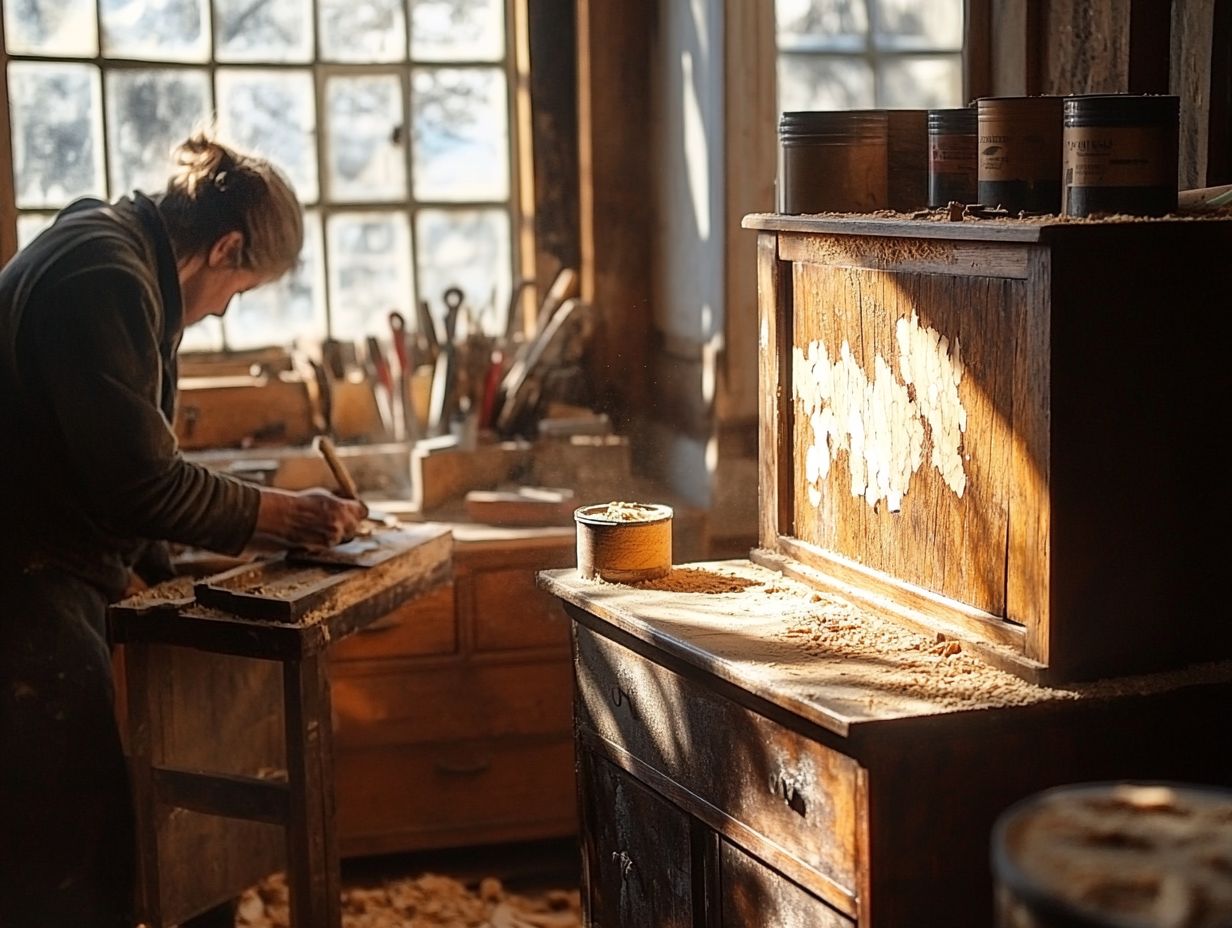
Repairing and refinishing your cabinets is essential. These steps address structural issues and refresh their look with a fresh wood finish.
Choosing the right type of wood finish and cabinet hardware is crucial for a cohesive look that complements your kitchen’s design theme. For those interested in enhancing their vintage pieces, check out Transforming Vintage Finds: DIY Restoration Tips to address common issues like filling scratches with specialized wood fillers that match the cabinet grain to ensure seamless repairs.
If you’re considering an upgrade, replacing outdated hardware can dramatically enhance the overall appearance of your cabinets. Techniques like sanding down the existing surface are vital for preparing it for new stain or paint. For those looking for more inspiration, transforming old furniture can offer quick DIY tips. Following up with several coats ensures durability, rejuvenating your cabinetry while protecting it for lasting beauty.
Maintaining Restored Cabinets
To keep your restored cabinets lasting long, regular maintenance is key. It protects your investment in your kitchen remodel.
By establishing cleaning routines and treating your cabinets with care, you can significantly extend their life and keep them looking pristine for years to come.
Tips for Long-Term Care
For lasting beauty, adopt effective long-term care strategies for your restored cabinets. This includes regular cleaning and implementing protective measures.
Use gentle cleaning products and avoid excessive moisture to maintain your cabinets. Incorporating specific cleaning techniques, like using a microfiber cloth to gently wipe surfaces, can help prevent scratches.
Choose pH-balanced cleaners or mild soap solutions that won t damage the cabinetry’s surface. Every few months, using wood conditioners can nourish the material and prevent drying or cracking.
Regularly inspect and tighten any loose hardware to ensure smooth function. Additionally, applying a protective sealant periodically acts as a barrier against spills and stains, enhancing your cabinets’ resilience over time.
Alternatives to DIY Restoration
Tackling a DIY cabinet restoration can be rewarding. However, consider the benefits of choosing professional refinishing services instead.
This option elevates the quality of the results and frees up your time, presenting a hassle-free solution for those seeking efficiency. By engaging experts, you ensure that every detail of the restoration is executed with precision and care, ultimately transforming your kitchen into a beautifully refined space.
Considering Professional Refinishing Services
Considering professional refinishing services can eliminate the stress of cabinet restoration for you. They provide access to expert knowledge and results that often surpass your DIY efforts. These experts use unique tools and methods that can really make your cabinets shine, significantly enhancing both their appearance and durability.
By hiring seasoned professionals, you benefit from their extensive expertise in materials and finishes. This allows for a more tailored approach that aligns perfectly with your tastes and the specific aesthetics of your home.
When selecting a cabinet restoration service, it s essential to weigh factors such as customer reviews, years of experience, and the range of services offered. A reliable service provider will showcase a portfolio of previous work, giving you confidence in their craftsmanship.
Taking the time to consider these aspects is crucial for achieving the transformation you want for your kitchen or bathroom space.
Frequently Asked Questions

What materials do I need for DIY restoration of old cabinets?
You will need sandpaper, paint or stain, primer (applying a base coat), brushes or rollers, a screwdriver, new hardware, and a cleaning solution.
Can I restore cabinets that are in poor condition?
Yes! With the right techniques and materials, even cabinets in poor condition can be given new life through DIY restoration.
How do I prepare the cabinets for restoration?
Start by removing all the hardware. Clean the surface of the cabinets with a solution of warm water and dish soap. Then, lightly sand the surface to remove any imperfections.
Do I need to prime before painting or staining the cabinets?
Yes, applying a base coat is an important step. It helps the paint or stain adhere to the surface and ensures a smooth finish.
Can I change the color of my cabinets during restoration?
Absolutely! You can choose to paint or stain your cabinets in a different color for a completely new look. Just make sure to properly prepare and prime the surface before applying the new color.
How long does DIY cabinet restoration take?
The time it takes to restore cabinets varies based on their condition and size, as well as your skill level. It can take anywhere from a few days to a few weeks.
Ready to transform your cabinets? Contact a professional today!


